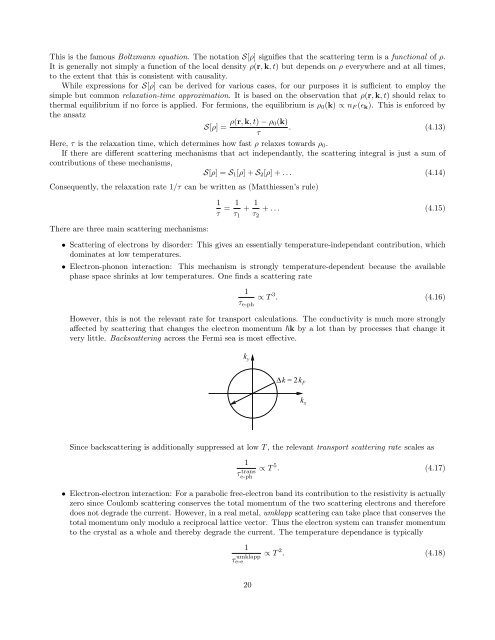Carsten Timm: Theory of superconductivity
Carsten Timm: Theory of superconductivity
Carsten Timm: Theory of superconductivity
Create successful ePaper yourself
Turn your PDF publications into a flip-book with our unique Google optimized e-Paper software.
This is the famous Boltzmann equation. The notation S[ρ] signifies that the scattering term is a functional <strong>of</strong> ρ.<br />
It is generally not simply a function <strong>of</strong> the local density ρ(r, k, t) but depends on ρ everywhere and at all times,<br />
to the extent that this is consistent with causality.<br />
While expressions for S[ρ] can be derived for various cases, for our purposes it is sufficient to employ the<br />
simple but common relaxation-time approximation. It is based on the observation that ρ(r, k, t) should relax to<br />
thermal equilibrium if no force is applied. For fermions, the equilibrium is ρ 0 (k) ∝ n F (ϵ k ). This is enforced by<br />
the ansatz<br />
S[ρ] = ρ(r, k, t) − ρ 0(k)<br />
. (4.13)<br />
τ<br />
Here, τ is the relaxation time, which determines how fast ρ relaxes towards ρ 0 .<br />
If there are different scattering mechanisms that act independantly, the scattering integral is just a sum <strong>of</strong><br />
contributions <strong>of</strong> these mechanisms,<br />
S[ρ] = S 1 [ρ] + S 2 [ρ] + . . . (4.14)<br />
Consequently, the relaxation rate 1/τ can be written as (Matthiessen’s rule)<br />
There are three main scattering mechanisms:<br />
1<br />
τ = 1 τ 1<br />
+ 1 τ 2<br />
+ . . . (4.15)<br />
• Scattering <strong>of</strong> electrons by disorder: This gives an essentially temperature-independant contribution, which<br />
dominates at low temperatures.<br />
• Electron-phonon interaction: This mechanism is strongly temperature-dependent because the available<br />
phase space shrinks at low temperatures. One finds a scattering rate<br />
1<br />
τ e-ph<br />
∝ T 3 . (4.16)<br />
However, this is not the relevant rate for transport calculations. The conductivity is much more strongly<br />
affected by scattering that changes the electron momentum k by a lot than by processes that change it<br />
very little. Backscattering across the Fermi sea is most effective.<br />
k<br />
y<br />
∆k = 2k<br />
F<br />
k x<br />
Since backscattering is additionally suppressed at low T , the relevant transport scattering rate scales as<br />
1<br />
τe-ph<br />
trans ∝ T 5 . (4.17)<br />
• Electron-electron interaction: For a parabolic free-electron band its contribution to the resistivity is actually<br />
zero since Coulomb scattering conserves the total momentum <strong>of</strong> the two scattering electrons and therefore<br />
does not degrade the current. However, in a real metal, umklapp scattering can take place that conserves the<br />
total momentum only modulo a reciprocal lattice vector. Thus the electron system can transfer momentum<br />
to the crystal as a whole and thereby degrade the current. The temperature dependance is typically<br />
1<br />
τ umklapp<br />
e-e<br />
∝ T 2 . (4.18)<br />
20

















